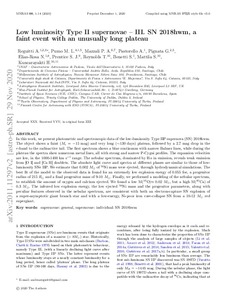Low-luminosity Type II supernovae - III. SN 2018hwm, a faint event with an unusually long plateau
Elias-Rosa N; Reguitti A; Pignata G; Reynolds T; Pumo ML; Mattila S; Pastorello A; Benetti S; Rodrìguez O; Mazzali PA; Kuncarayakti H; Prentice SJ
https://urn.fi/URN:NBN:fi-fe2021042827500
Tiivistelmä
In this work, we present photometric and spectroscopic data of the low-luminosity (LL) Type IIP supernova (SN) 2018hwm. The object shows a faint (Mr = -15 mag) and very long (~ 130 d) plateau, followed by a 2.7 mag drop in the r band to the radioactive tail. The first spectrum shows a blue continuum with narrow Balmer lines, while during the plateau the spectra show numerous metal lines, all with strong and narrow P-Cygni profiles. The expansion velocities are low, in the 1000-1400 km s-1 range. The nebular spectrum, dominated by H α in emission, reveals weak emission from [O I] and [Ca II] doublets. The absolute light curve and spectra at different phases are similar to those of LL SNe IIP. We estimate that 0.002 M⊙ of 56Ni mass were ejected, through hydrodynamical simulations. The best fit of the model to the observed data is found for an extremely low explosion energy of 0.055 foe, a progenitor radius of 215 R⊙, and a final progenitor mass of 9-10 M⊙. Finally, we performed a modelling of the nebular spectrum, to establish the amount of oxygen and calcium ejected. We found a low M(16O)≈ 0.02M⊙, but a high M(40Ca) of 0.3 M⊙. The inferred low explosion energy, the low ejected 56Ni mass, and the progenitor parameters, along with peculiar features observed in the nebular spectrum, are consistent with both an electron-capture SN explosion of a superasymptotic giant branch star and with a low-energy, Ni-poor iron core-collapse SN from a 10-12 M⊙ red supergiant.
Kokoelmat
- Rinnakkaistallenteet [19207]
